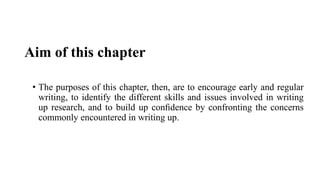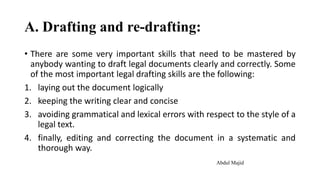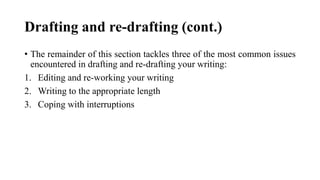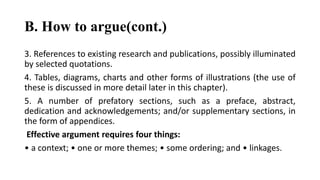Writing up
- 2. Writing Up Skills Presented To: DR. Ghulam Sarwar Presented by: Muhammad Usman E256 M.Humza dildar M045 Asif Ayub E231 Abubakar M101 Abdul Majid M069
- 3. Aim of this chapter • The purposes of this chapter, then, are to encourage early and regular writing, to identify the different skills and issues involved in writing up research, and to build up confidence by confronting the concerns commonly encountered in writing up.
- 4. Introduction • Research without writing is of little purpose. • The rapid development of new information and computer technologies may have changed the speed and scope of such communication, but it has not altered the importance of writing as the means for communicating. • Writing up your research should start early and become a regular and continuing activity. • It is also likely to be an iterative or cyclical process.
- 5. Key point for writing up: • Drafting and re-drafting: how to progress your writing up. • How to argue: the organisation and structure of your writing. • How to criticize: placing your work in the context of that of others. • Who am I writing for?: writing appropriately for your audience. • Grammar, referencing and plagiarism: some hints and tips. • Using tables, diagrams and other illustrations: when and when not to. • Panics: common worries encountered in writing up research.
- 6. A. Drafting and re-drafting: • There are some very important skills that need to be mastered by anybody wanting to draft legal documents clearly and correctly. Some of the most important legal drafting skills are the following: 1. laying out the document logically 2. keeping the writing clear and concise 3. avoiding grammatical and lexical errors with respect to the style of a legal text. 4. finally, editing and correcting the document in a systematic and thorough way. Abdul Majid
- 7. Drafting and re-drafting (cont.) • The remainder of this section tackles three of the most common issues encountered in drafting and re-drafting your writing: 1. Editing and re-working your writing 2. Writing to the appropriate length 3. Coping with interruptions
- 8. 1. Editing and re-working your writing • Once you have written something – anything – the writing up process becomes in part a process of re-writing what you have already written. You will need to re-write in order to: • bring in new material, ideas and thinking • reduce the length of what you have written • revise old sections to refer to newly drafted material; • alter the structure of what you have written; • respond to the suggestions made by your readers; • remove any inadvertent repetitions.
- 9. 2. Writing to the appropriate length • There are two basic approaches which you can then adopt for writing to a given length: 1. the planned approach, where you sketch out the contents of your report or thesis in some detail, allocate a given number of words or pages to each sub-section, and then endeavour to keep to those lengths as you draft; 2. the slash and burn approach, where you initially draft without reference to any length constraints, and then subsequently cut down or extend your drafts as necessary. Asif Ayub
- 10. B. How to argue • Writing up your research, whether in the form of a work report or an academic thesis, requires particular skills and forms of organization. • The extent to which you make use of these will vary depending on the size and scope of your research project. • Some points are important for this purpose: 1. An introduction, at the beginning, and a set of conclusions, at the end. 2. A series of distinct sections or chapters, which may be further divided into sub-sections or sub-chapters.
- 11. B. How to argue(cont.) 3. References to existing research and publications, possibly illuminated by selected quotations. 4. Tables, diagrams, charts and other forms of illustrations (the use of these is discussed in more detail later in this chapter). 5. A number of prefatory sections, such as a preface, abstract, dedication and acknowledgements; and/or supplementary sections, in the form of appendices. Effective argument requires four things: • a context; • one or more themes; • some ordering; and • linkages.
- 12. Possible forms for an academic thesis The ‘classic’ dissertation structure is: • contents • abstract • introduction (10% of words or space) • review of the background literature (20%) • design and methodology of the research (10%) • implementation of the research (15%) • presentation and analysis of data (15%) • comment and critique of the outcomes or findings (20%) • summary and conclusion (10%) • references • bibliography • appendices
- 13. C. How to criticize • Criticism is evaluation. It should be careful, considered and justified. • Anything may be criticized: underlying assumptions, arguments, methodologies, the accuracy of data collected, the interpretation of that data. • Key point of criticized 1. Using your sources 2. Establishing your argument 3. Going back to the literature Ali Usman
- 14. D. Grammar, punctuation and spelling: • Some tips on grammar and punctuation: 1. Try and avoid long sentences 2. Avoid one-sentence paragraphs 3. Avoid beginning sentences with ‘joining’ words, such as ‘but’, ‘and’ or ‘because’ 4. Avoid incorporating lengthy lists of material in your text 5. Understand and make use of the full range of standard punctuation forms; including, in particular, the colon (:), semi-colon (;), comma (,) and full stop (.) 6. Use quotation marks (“and’) consistently
- 15. E. Using tables, diagrams and other illustrations • It can be a good idea to include tables, diagrams and other illustrations in your research report or thesis, providing that these are both permitted and relevant. • Such illustrations may serve to illuminate, break up, extend and confirm your writing. • Tables may be used to summarize information, usually in a numerical format, and to indicate the relationships between the different variables under consideration. • Diagrams are also useful for indicating relationships and structures: they can convey ideas much more effectively than lengthier textual explanations. Humza Dildar
- 16. F. Panics • The process of writing up, like many aspects of doing research, is likely to give rise to a number of common worries, particularly among relatively new researchers. We end this chapter, therefore, by considering four of the most common reasons for panics: 1. If it’s new to me, is it original? 2. I’ve just discovered someone has written this before. 3. It’s all a load of rubbish. 4. Conflicting advice.
















